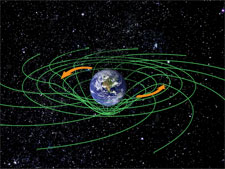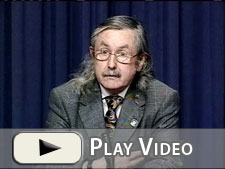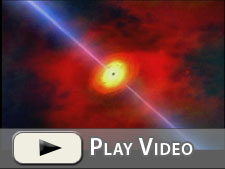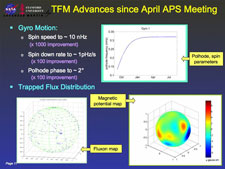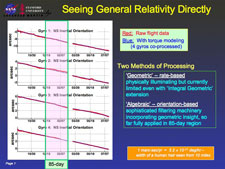MISSION UPDATE — May 23, 2008
PROGRAM STATUS
NASA’s 2008 Senior Review of GP-B
In March 2008 at NASA's invitation, we submitted a proposal to the Science Mission Directorate, Astrophysics Division Senior Review of Operating Missions (Sr. Review), requesting a final 18-month (October 2008 through March 2010), $3.8M extension of GP-B to complete the data analysis and publish the results. In April, as part of the Sr. Review process, GP-B Principal Investigator, Francis Everitt, and Program Manager, William Bencze, made a presentation to the Sr. Review Committee at NASA Headquarters, where it appeared to have been favorably received.
Thus, we were greatly surprised last week to discover that the Sr. Review had recommended that NASA not grant our final funding extension, particularly since another NASA committee—the GP-B Science Advisory Committee (SAC), chaired by relativistic physicist Clifford Will—stated in its report following the November 2007 meeting: “The SAC was impressed with the truly extraordinary progress that has been made in data analysis since SAC-16 [Mar 2007] … and we now agree that GP-B is on an accelerating path toward reaching good science results.”
The Sr. Review evaluation is an unexpected setback, but we are determined to push ahead and drive to the very best possible result within the resources available.
The Plight of Fundamental Physics Research at NASA
While the Sr. Review outcome has ramifications for GP-B, in broader terms, it points to the challenge of finding support for fundamental physics experiments within the NASA culture of observational missions. This has been an ongoing issue within NASA for decades. In the 1990s, fundamental physics research experiments were scattered over several divisions of NASA, which led in 1999, to the blue-ribbon NASA Advisory Council (NAC) recommending to the NASA Administrator that the agency create a "single home room" for physics missions in space so that these missions would be given the support and visibility they deserved.
The 1999 NAC committee's advice was never heeded. Furthermore, during the 2004 restructuring and consolidation of NASA divisions, the already small budget for fundamental physics research was cut to zero in the NASA Exploration Directorate, entirely eliminating fundamental physics research from that division. This left the Science Mission Directorate (SMD) as the only home for fundamental physics experiments like GP-B. However, in the SMD, physics experiments had to compete directly with the NASA Great Observatories and other astrophysics missions for pieces of an already-decimated research budget. It is no criticism of the SMD Sr. Review to say that of the ten missions under review, GP-B as a physics experiment rather than an observatory was quite unlike the rest and almost impossible to fit within a common intellectual framework. Regrettably, since NASA has failed to establish a fundamental physics research division, several missions besides GP-B have suffered. If such a division existed, we believe the agency’s support for the proper completion of GP-B would continue to be strong.
The Continued Relevance & Importance of GP-B
One of the Sr. Review Committee’s main arguments supporting its recommendation that NASA not fund the final extension requested by GP-B, was that the goals of GP-B have already been fulfilled by other measurements, and that GP-B is therefore no longer relevant. This view is in stark contrast with the recommendations of the SAC (2007), NASA’s Turner panel review of GP-B (2003), and NASA’s Fitch-Taylor NRC review of GP-B (1995). All of these reviews concluded that the GP-B experiment is scientifically justified and should be completed.
Now, in 2008, the scientific justification for completing the GP-B experiment is even more valid. During the past five years, there has been little progress on other relativity experiments, but GP-B was launched, operated, and collected all of the necessary data. After two years of intense work, the GP-B science team is very close to completing the data analysis. GP-B has made, in the view of the SAC, “extraordinary progress” in addressing two unexpected and difficult complications in analysis caused by unanticipated electrostatic patch effect fields within the gyroscope. (These have been reported previously in our status updates dated Summer 2007, September 2007 and December 2007.)
GP-B directly studies gravity, one of the most fundamental laws of nature. Inherently, the goals of GP-B differ significantly from those of typical astrophysics missions, where natural laws—inferred theoretically and tested on the ground—are used to interpret observations of astrophysical phenomena. Furthermore, GP-B objectives and methods are qualitatively different from those underlying most astrophysical work. For this reason, the GP-B experiment begs to be evaluated with respect to criteria based on its direct experimental methodology. Direct tests of nature’s laws are the foundation of physical science; such tests are the only rational basis for the belief that these laws are, in part, “understood.” GP-B seeks to deepen our understanding of gravity in this way.
In addition to its scientific significance, GP-B's technological heritage and operational experience is critically important for future gravity space missions, including tests of the equivalence principle (STEP) and the search for gravitational waves (LISA). NASA stands to loose much of the expertise developed on the GP-B mission if the program is not brought to a proper conclusion.
The Road Ahead
Our GP-B team has been making steady progress in analyzing the data and working through the unexpected complications discovered within the data. We are now in the home stretch. We have identified the issues that still need to be addressed, and we have prepared a sound plan for completion of the analysis. This plan, which was spelled out in detail in our proposal to the NASA Sr. Review, requires an additional 18-month investment of $3.8M from September 2008 through March 2010. If no further funds are forthcoming from NASA, the analysis efforts will likely cease by October 2008, unless other funding sources can be identified. Since February 2008, GP-B has been funded by contributions from NASA, Stanford University, and a private donor, in approximately equal shares.
We have now clearly confirmed the geodetic effect to a precision of less than 1.5% (97 milli-arcseconds/year). However, because the frame-dragging effect is ~170 times smaller, removing the sources of error from that measurement—especially the non-relativistic torques due to patch effect interactions between the gyro rotors and their housings—is a detailed, painstakingly slow process. We have yet to reach a point of diminishing returns. Until we do, it is our intention to push onward and obtain the best result possible to properly complete this landmark experiment.
We will continue to keep you posted on our progress.
LINKS TO OTHER GP-B TOPICS
- GP-B Frequently Asked Questions (FAQ)
- Track the satellite in the sky
- Build a paper model of the GP-B Spacecraft
- Our mailing list—receive GP-B status updates via email
- View a Flash video of Professor Everitt's 18 May 2006 lecture on GP-B
Note: Both audio-only and video versions of this lecture are also available on the Stanford on iTUNES U Web site. This Web page automatically launches the Apple iTunes program on both Macintosh and Windows computers, with a special Stanford on iTunes U "music store," containing free downloads of Stanford lectures, performances, and events. Francis Everitt's "Testing Einstein in Space" lecture is located in the Science & Technology—Engineering section. People with audio-only iPods can download the version under the Audio tab; people with 5th generation (video) iPods can download the version under the Video tab.
Previous Update | Index of Updates



